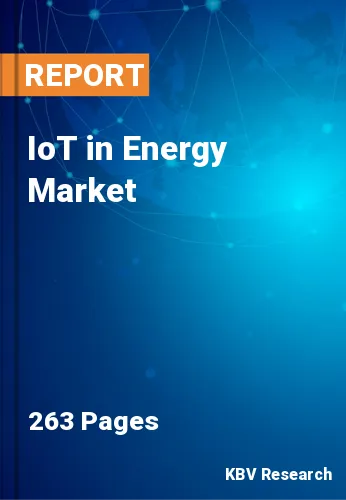The Global IoT in Energy Market size is expected to reach $357.4 billion by 2028, rising at a market growth of 19.7% CAGR during the forecast period.
The Internet of Things (IoT) platform comprises web-connected smart devices that gather, analyze, and maintain data utilizing sensors, communication hardware, and CPUs. IoT symbolizes a new production reality. By gathering, transferring, and combining vast quantities of data, IoT in the energy industry produces intelligent networks referred to as smart grid. Hence, it intelligently combines all network-connected assets, improves operations, and boosts system flexibility.
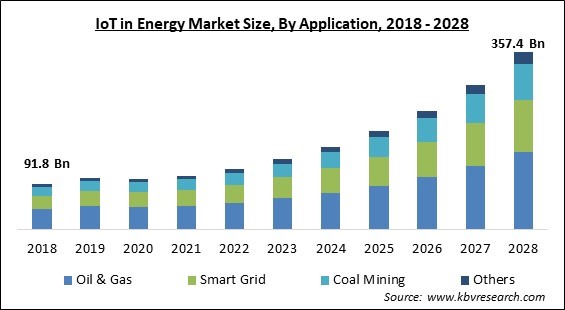
Therefore, it aids in the creation of new services, increases efficiency and production, addresses crucial issues, and enhances real-time decision making. In addition, the increased usage of IoT and AI in the energy business is expected to create attractive potential prospects for the market. In addition, the implementation of smart grid for energy optimization in residential, commercial, and industrial buildings will further accelerate the IoT in Energy Industry's growth throughout the forecast period.
Combining renewable energy and energy efficiency can facilitate sustainable energy transitions and prevent climate change. IoT becomes a disruptive technology which has facilitated a beneficial transformation in the energy sector by reducing demand. Internet of Things applications include energy supply, transmission, generation, and distribution, among others. In addition, IoT may be deployed to enhance energy efficiency, increase the use of renewable energy, and reduce the environmental effect of energy consumption.
The growth of IoT in the energy sector has been substantial in recent years, and this trend is anticipated to continue in the coming years. In particular, IoT is expected to have a significant influence on the energy industry. During the pandemic, IoT had proved extremely beneficial for the energy industry, with sensors allowing surveillance of room temperatures as well as remote control of energy use. This contributed not just to cost savings but also to sustainable development.
Environmental sustainability and demand growth are the most troublesome concerns facing the energy business. With increased IoT usage, enterprises and individuals can do a great deal to protect the environment using such devices and data analytics. IoT reduces waste and increases system efficiency. The deployment of IoT technology in business and residential buildings enables the monitoring and control of energy use, hence reducing their energy demand and increasing their efficiency.
The Internet of Things (IoT) in the energy industry is a sophisticated procedure that encompasses planning & energy management of consumption patterns across different domains. It enables managers to take total control of energy data from inception and considerably optimize the operation. Implementing an IoT-enabled solution in the energy industry employs sensor-based approaches to automate the industry's operations. This has maximized the sector's benefits through real-time data management and analytical decision-making.
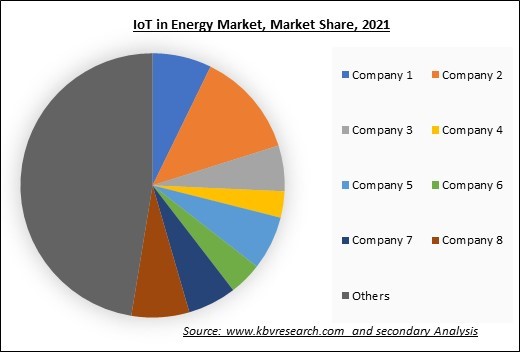
The leading players in the market are competing with diverse innovative offerings to remain competitive in the market. The below illustration shows the percentage of revenue shared by some of the leading companies in the market. The leading players of the market are adopting various strategies in order to cater demand coming from the different industries. The key developmental strategies in the market are Partnerships & Collaborations.
Maintaining the data collected and transferred by IoT devices secure is difficult as their use expands and evolves. Despite the importance of cybersecurity, IoT devices are not usually incorporated in the plan. Systems must be safeguarded against physical manipulation, network-based attacks, internet-based software assaults, and hardware attacks. The adoption of IoT devices in highly sensitive areas, like healthcare and banking, raises additional concerns regarding data security.
Based on application, the IoT in energy market is classified into Oil & Gas, Smart Grid, Coal Mining and Others. The coal mining segment registered a significant revenue share in the IoT in energy market in 2021. The internet of things (IoT) has facilitated coal mining. With this technology, it is simple to track the whereabouts of miners. The internet of things (IoT) technology also aids in monitoring the entire mining operation.
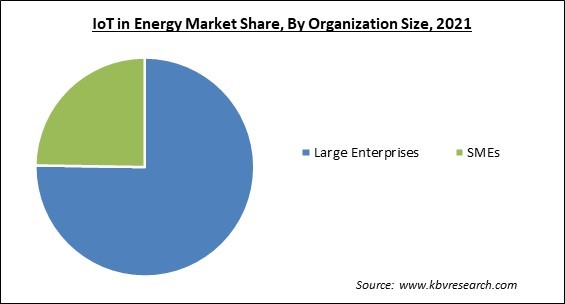
On the basis of network technology, the IoT in energy market is divided into Cellular Network, Satellite Network, and Radio Network. Radio Network segment recorded the highest revenue share in the IoT in energy market in 2021. LPWAN is the principal radio network technology which appears to be suited (Low Power Wide Area Network). LoRa radio technology refers to an open industry standard that is widely accessible owing to its widespread use. This technology is the foundation for the "Internet of Things". Thus, this segment would witness a surge in growth over the forecast period.
On the basis of component, the IoT in energy market is bifurcated into Solutions and Services. The services segment recorded a significant revenue share in the IoT in energy market in 2021. This is due to the multiple benefits given by services that provide high-quality machining & manufacturing services whilst also keeping the highest industry standards for health, safety, and the environment. This aspect is anticipated to drive the growth of the IoT market in the energy sector.
By organization size, the IoT in energy market is segmented into Large Enterprises and SMEs. Large enterprises segment garnered the maximum revenue share in the IoT in energy market in 2021. IoT adoption in energy offers multiple advantages to large enterprises, including renewable energy source, increased industry efficiency and cost reduction, conversion of existing lighting systems to energy-efficient solutions, facilitation of energy savings for customers, and provision of smart technology solutions, that also fuels market growth.
| Report Attribute | Details |
|---|---|
| Market size value in 2021 | USD 107.9 Billion |
| Market size forecast in 2028 | USD 357.4 Billion |
| Base Year | 2021 |
| Historical Period | 2018 to 2020 |
| Forecast Period | 2022 to 2028 |
| Revenue Growth Rate | CAGR of 19.7% from 2022 to 2028 |
| Number of Pages | 263 |
| Number of Tables | 433 |
| Report coverage | Market Trends, Revenue Estimation and Forecast, Segmentation Analysis, Regional and Country Breakdown, Competitive Landscape, Market Share Analysis, Companies Strategic Developments, Company Profiling |
| Segments covered | Component, Organization Size, Network Technology, Application, Region |
| Country scope | US, Canada, Mexico, Germany, UK, France, Russia, Spain, Italy, China, Japan, India, South Korea, Singapore, Malaysia, Brazil, Argentina, UAE, Saudi Arabia, South Africa, Nigeria |
| Growth Drivers |
|
| Restraints |
|
Region-wise, the IoT in energy market is analyzed across North America, Europe, Asia Pacific and LAMEA. Asia Pacific acquired a significant revenue share in the IoT in energy market in 2021. This is a result of more IoT penetration in the energy sector and greater use of IoT devices and technologies, that drives market expansion in the area. The expansion of the internet of things (IoT) in the Asia-Pacific energy sector is being pushed by technical advances.
Free Valuable Insights: Global IoT in Energy Market size to reach USD 357.4 Billion by 2028
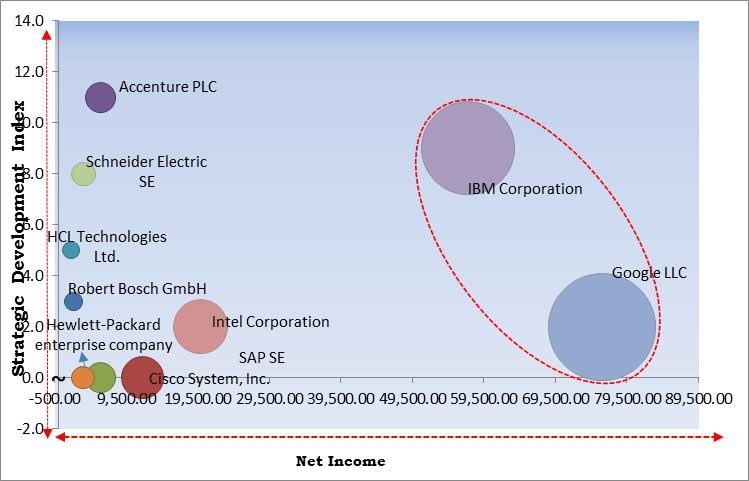
The major strategies followed by the market participants are Partnerships. Based on the Analysis presented in the Cardinal matrix; Google LLC and IBM Corporation are the forerunners in the IoT in Energy Market. Companies such as Intel Corporation, Cisco System, Inc. and Accenture PLC are some of the key innovators in IoT in Energy Market.
The market research report covers the analysis of key stake holders of the market. Key companies profiled in the report include Accenture PLC, IBM Corporation, Cisco Systems, Inc., Hewlett-Packard Enterprise Company, Intel Corporation, SAP SE, Schneider Electric SE, Robert Bosch GmbH, Google LLC and HCL Technologies Ltd. (HCL Enterprises).
By Application
By Network Technology
By Component
By Organization Size
By Geography
The global IoT in Energy Market size is expected to reach $357.4 billion by 2028.
Integration of IOT Devices Improves the Reliability and Productivity of Industry are driving the market in coming years, however, Problem Associated With Security and Discretion restraints the growth of the market.
Accenture PLC, IBM Corporation, Cisco Systems, Inc., Hewlett-Packard Enterprise Company, Intel Corporation, SAP SE, Schneider Electric SE, Robert Bosch GmbH, Google LLC and HCL Technologies Ltd. (HCL Enterprises).
The Solution market acquired the maximum revenue share in the Global IoT in Energy Market by Component in 2021; thereby, achieving a market value of $237.0 billion by 2028.
The Oil & Gas market is leading the Global IoT in Energy Market by Application in 2021; thereby, achieving a market value of $155.7 billion by 2028.
The North America market dominated the Global IoT in Energy Market by Region in 2021, and would continue to be a dominant market till 2028; thereby, achieving a market value of $129.4 billion by 2028.
Our team of dedicated experts can provide you with attractive expansion opportunities for your business.
